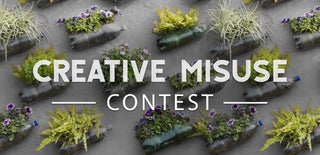Introduction: Yellow Jacket Ground Nest Trap From 5 Gallon Water Bottle
What a wonderful summer! The weather's been nice. The garden is plentiful. It's been great cooking out on the grill and having dinner outside nightly. And then....YELLOW JACKETS! What a way to ruin a good time outside, especially when hitting a ground nest with the lawn mower. After a trip to the pharmacy for itch cream for my wife's stings I went to the hardware store to get some spray. Several kinds. Several different active ingredients. Several nights going out to spray the opening. Nothing worked. I think the spray acted as a super-multi-mega vitamin for them because the activity of the nest increased each day as they multiplied instead of died.
Ready to go indoors until the temperature dropped I figured that there must be a way to get rid of them. I saw an extra 5 gallon water bottle and thought there must be a way to use it to make a trap. And the rest is history...and so are the yellow jackets!
Step 1: Gather the Supplies
The materials list is short and cheap.
1 - 5 gallon water bottle
1 - can of wasp spray
1 - roll of tape (wide packing type tape is best)
The only tool needed is a saw or snips, whichever you prefer for cutting the bottle.
Step 2: Cut the Top Off the Bottle
Cut the top off the bottle with your saw or shears. I used the back of my machete since it was within arm's reach when I started making this. Where else would I have it?
This bottle has easy lines to follow to keep the cut straight and even all the way around.
Step 3: Fasten the Top
Turn the top upside down and place it on the topless bottle. Now it's a bottle with an inverted top. Tape the two pieces together. This is where the wider tape comes in handy. It was easy to run it around the outside and then fold it over, securing the two pieces nicely. I thought about using some sort of glue but realized I wouldn't be able to empty the many yellow jackets I will catch if the pieces are permanently attached.
Step 4: Your Trap Is Finished!
The trap is now complete. This was probably one of the fastest projects I've done. But the true test was yet to come. Will this trap actually trap?
To find out I went to the nest in the dark. I would suggest you do the same. I sprayed some of the wasp spray into the nest and placed the trap upside down over the hole, making sure there were no gaps around the edges. Then I went inside to eagerly await the rising of the sun to see what happened.
Step 5: Success
It worked like a champ! In the morning as the yellow jackets left the nest they flew right into the bottle and were unable to get out. The fumes from the spray quickly and humanely killed the yellow jackets. A few seemed to have gotten out around the edges (or possibly from a second hole in the ground that I can't find) but the population of the nest has definitely decreased significantly.
Step 6: Additional Thoughts
If you try this please consider the type of flying, biting, stinging things you are dealing with. Yellow jackets can be aggressive and dangerous. There is a large honey bee nest in our yard I am leaving alone and do not want to disturb since the benefit of them outweighs the risk. I think this trap could be used without poison to catch and relocate by taking them somewhere and removing the tape. And then run as fast as you can!

Runner Up in the
Creative Misuse Contest













